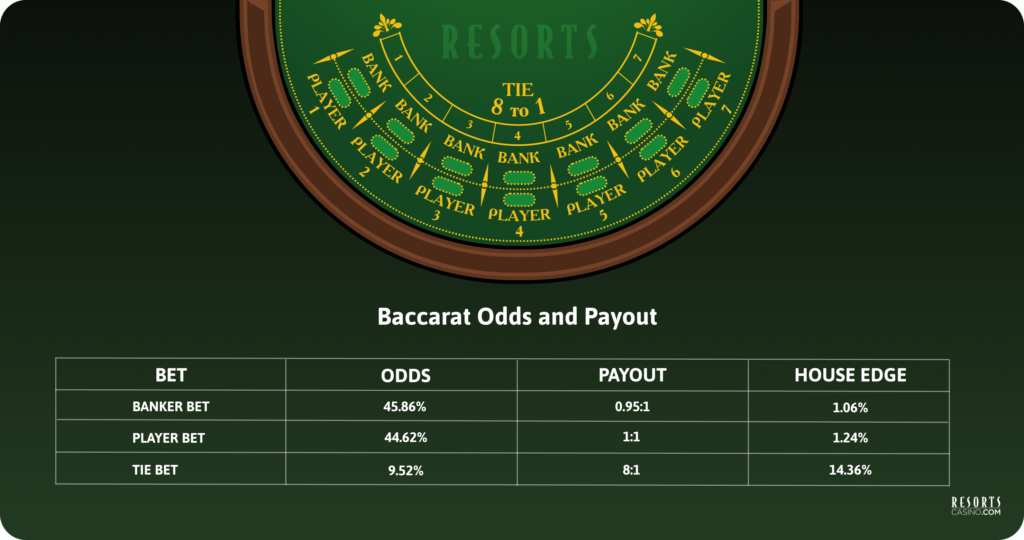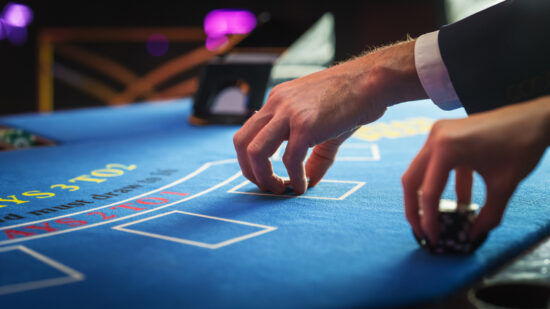Baccarat odds and payouts explained
Some gamblers avoid baccarat because they assume it is a complicated game for high-rollers. It isn’t; all it takes is wrapping your head around the rules.
People have been playing baccarat for hundreds of years, so you can easily pick it up as well. As we’ll see in this article, understanding baccarat odds isn’t difficult.
We’ll look at the payouts in baccarat, which is all about how much you take home for every game you win. The article will also explain the house edge in baccarat, which is how much the casino gets to keep, as well as the best betting strategies in baccarat.
Before we get into all that, let’s take a minute to get acquainted with baccarat and how it is played.
Baccarat is a guessing game. You sit at a table and decide how much (in the form of chips) you would like to bet and then choose one of two possible winning sides: the banker or the player. There is a third, higher bet, but we’ll come to that a little later.
Each of these hands is dealt two cards by the dealer, all facing up. All 10s are counted as zeroes, but all other cards carry their face value.
The hand that has cards that total closest to nine wins the round. If you bet on the player and they win, you double your bet, in effect doubling your winnings. If the banker wins, you get back 95% of what you bet.
To put it simply, it is typically better to bet on the player. However, there are times when it makes more sense to bet on the banker.
If the cards add up to a number that is higher than nine, the rules of the game state that you must drop the one. For example, say you have two cards, 7 and 5. They add up to 12, and if you drop the one, your cards come to a total of two.
Several basic rules must be observed in a game of baccarat, and it is important to familiarize yourself before you get started. The language may seem confusing at first, but it will become familiar after a few games.
Remember, although it is a game of chance, winning in baccarat is determined by how well you know the rules. Your familiarity with the game will allow you to strategize about how to place your bets.
Understanding baccarat odds
Odds are the chances a player stands to win or lose against the house. They are generally considered unchanging, but depending on how a game is played, they can change.
There are three possible hands that a player can bet on: the banker to win, the player to win or a tie. In other words, either the banker or the player wins, or they come up even.
The banker’s odds of winning a game are 45.86%. This means there’s nearly a 50/50 chance of you winning as long as you bet on the banker.
If you bet on the player, the odds drop slightly to 44.63%. The difference between the two is a little over 1%, but it can make a big difference for those who bet large amounts.
A tie is what happens if both the player and the banker happen to have cards that add up to the same number. It has odds of 9.51%. If you remove the tie, the banker wins around 51% of all games.
By these numbers alone, it makes sense to bet on the banker, but remember that you have to take the payout into account.
You may be wondering how the odds of baccarat compare with other games. Blackjack has odds of 42% while roulette has odds of 47%. Craps hold the highest odds at 49.3%.
Payouts in baccarat
If you bet on the banker and you win, the payout is 1:1. This means that if you bet $10, for example, and you win, you walk away with $20. However, you have to pay the house 5%, which reduces your winnings to $19.
If your bet is on the player’s hand and you win, the payout is the same (1:1). However, you don’t owe the house anything, and using the above example, you walk away with a full $20.
The trickiest of all baccarat payouts is the tie bet. Remember, it has very low odds of 9.51%, but if you should win, the payout is 8:1. If you bet $10 and you win, you get to walk away with $80.
However, there is a huge difference between how much you win and how much you take home. A tie draws a commission of 14.36%. In our example above, your take-home amount would be about $68.

As a player, you’ll need to decide what kind of risks you’re willing to take. Tie bets are recommended for experienced players who can “read” the action on the table and strategize.
For beginners, it is a good idea to bet on the player. The odds of winning are highest, and you do not pay any commission on the money you make.
If you are keen on taking tie bets but don’t have much experience, you shouldn’t bet large amounts as that will only lead to big losses.
House edge in baccarat
The baccarat house edge is how much the casino wins for every game. It may not seem significant when you’re playing small amounts for short periods, but when you start to bet big and play for longer periods, your average losses will come pretty close to the house edge.
If you bet on the banker, the house takes 1.06%. The player’s hand has a house edge of 1.24%, while the tie has a huge house edge of 14.36%.
In comparison, blackjack has the lowest house edge of any casino game. You only pay 0.5% of your winnings. For roulette, the commission is quite high at 5.26%.
Always remember that the casino must take its share. You may choose a game with a low house edge, but if you play long enough, you will lose as if you were playing a game with a high house edge.
By now it should be clear that baccarat is a game of balance. Every hand has advantages, but it also has drawbacks. It is purely a game of chance, although there are some strategic tips you can apply that increase your odds of winning.
Betting strategies in baccarat
Now that you’re familiar with the different hands you can bet, the odds, the payouts and the house edge, you’ll naturally want to learn about how you can increase your odds of winning.
Below are some baccarat strategies, but even as you put them into action, you must always remember that baccarat doesn’t come with any guarantees. It is a game of pure chance. There is nothing you can do to influence the winning hand. The important thing is where and how you place your bets.
Tie bets
This is one of the first strategies that is given to beginners, and from the numbers we’ve discussed above, you can see why. Tie bets have a very healthy payout, but they have extremely low odds and attract a high house edge.
Let’s say you decide to place 100 wagers for $1 each. If you choose a tie bet, you will have to surrender about $15 of that to the house, and that’s after you factor in that you stand very low chances of winning anyway.
If you continued to place similar bets, you would empty your wallet sooner or later. Any gambling game should be fun and fill up your wallet at the same time. If you insist on tie bets, you’ll soon stop having fun, and before you know it, you’ll have emptied your bankroll.
So why have the tie at all? It is for risk-takers. Some don’t mind dealing with that kind of risk, and high-rollers can afford it. They hope to win, but if they don’t, it isn’t a big deal; they came in with a big bankroll anyway.
The house hopes that one or two players will take a tie bet each night, because for the casino, it means a significant payout.
The banker’s bet is a smart move
The banker is an effective and safe bet whether you’re a beginner or an experienced player.
It is all in the math. It has the highest odds, and even if you take into account the house edge, you still come out on top.
Its payout is the same as the player’s hand, but if you take into account the higher odds, there is a better chance of winning.
If you make 100 bets of $1 each and you win, you get to pocket a profit of $98.94. If you disregard the tie bet, the banker’s hand has more than 50% odds of winning for each bet you place.
The player’s bet may not be far behind, but remember that the more you play, the more significant small numbers become.
Use the Martingale strategy
Some people don’t wish to place banker’s bets. This doesn’t mean they cannot play a smart baccarat game. Some advanced systems have been known to yield results even with tie bets.
One of these is the Martingale system, which has been used by players for hundreds of years. In more recent times, it has also been used in forex trading, securities and other investments that are looking for long-term profitability.
The system was invented by Frenchman Paul Pierre Levy but was popularized by casino owner John Martingale.
It is based on the simple theory that over time, historical returns will return to a long-term average.
In baccarat, this means that you shouldn’t stop playing just because you lose. If you keep playing, you increase your odds of winning. The Martingale system advises that each time you lose, you should double your betting amount.
Say you place a $10 bet and lose. Rather than quit, you should play in the next round and place a $20 bet. If you lose that, place a $40 bet, and should you lose that, place an $80.
If you win at this point, you should go back to placing $10 bets, the original amount that you had placed. The thinking is that losing streaks can only last so long. It is a mathematical theory that takes into account probability.
There is an immediate problem with this strategy though; you need to have a relatively big bankroll to use it effectively.
Using the above example, you should be prepared to place bets of at least $150. If you can afford it, there are good odds that you will win a healthy return on your bets.
Some people hope for early wins so that they can use the money to play using the Martingale system. This relies purely on luck because if you lose, you cannot continue to play.
Some casinos have banned the Martingale system, so before you use it, it’s a good idea to first check whether it’s allowed.
The Fibonacci strategy
The Fibonacci strategy helps gamblers decide how much they should bet after they lose. It uses the theory that each number is a sum of the two that come before it.
Take the number 1, for example. Before it comes 0 and 1, and the sum of that is 1. If you use this sequence, you will come up with numbers that look like this: 1, 1, 2, 3, 5, 8, 13, 21 and so on.
This system requires that players be fast on their feet because they have to do complex computations on the go. However, it doesn’t mean that you have to be a math whiz. The Fibonacci strategy may seem a little complicated at first, but like most things, the more you use it, the easier it becomes.
Again, the problem with this strategy is that you need to have a healthy bankroll to begin with if you are going to multiply your bets using the above sequence. You also have to play for extended periods to see returns.
The Fibonacci strategy works best for high-rollers who have plenty of time to spend at the baccarat table.
Try the Paroli system
This strategy goes as far back as the 16th century. Some people call the Paroli system the reverse Martingale. According to some, the fact that gamblers were using it centuries ago in Italy is evidence that it works.
The premise is simple: double your bets every time you win until you start losing. The big assumption here is that you will start winning immediately after you join the game and keep winning for at least three games.
The Labouchere system
With the Labouchere system, the player is required to create a sequence. It doesn’t have to follow any specific format, but the player should choose something easy for them to use.
Once the sequence is in place, you should bet the sum of the first and last number. If you win, cross off the numbers that gave you the win. If you lose, add the number you lost to the end of the sequence and then bet the sum of the first and last numbers.
Conclusion
Baccarat may be a game of chance, but understanding the odds, payout and the house edge are important to the experience. It is also vital that you choose a reputable casino. One of the best is Resorts Casino in New Jersey. They have baccarat tables for in-person games as well as live baccarat and online baccarat.
Comments
Comments are closed.





Pingback: Top Advanced Baccarat strategy - Resorts Casino